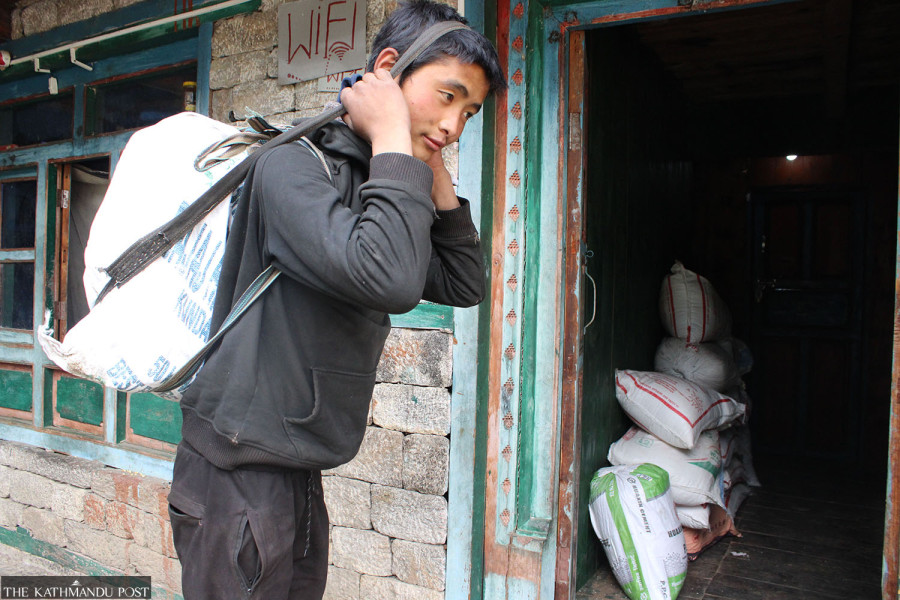Gandaki Province
Food distribution centres set up in north Gorkha
The residents of far-flung settlements in Chumnubri Rural Municipality express relief.
Hariram Upreti
Tsering Lama, a 35-year-old man from Chhekampar, Chumnubri Rural Municipality-7, has a family of three. Until the last week of April, Lama had to travel for a day to buy rice from the Philim depot in Sirdibas in Ward 3. He would return home the next day.
Lama will no longer have to make the journey since two food distribution centres—one at Chumling in ward 6 and the other at Namrung village in ward 4—came into operation following an April 16 decision by the Ministry of Supply and the Food Management and Trading Company.
“Before the operation of the food distribution centre in Chumling and Namrung, people were forced to undertake a two-day journey just to buy rice and return home,” said Lama. “The way to Sirdibas is risky, especially during the rainy season. So the operations of the two food distribution centres have come as a relief to us.”
Chumnubri Rural Municipality is the largest local unit of Gorkha district in terms of geography. There are seven wards in the rural municipality that borders Tibet in China.
Chhekampar, Chumchet, Lho, Prok, Bihi, and Samagaun are some of the remotest settlements in the rural municipality. It takes at least two days on foot to reach most of these villages from the food depot at Philim. Chhekampar is a one-day walk from Sirdibas, while it takes two days to reach Samagaun, which borders Tibet.
Before the Covid pandemic, the residents of Chhekampar, Chumchet, and Samagaun used to frequent the border point in Chhekampar to go to the market across the border for daily essentials. However, the border point remains closed since the pandemic.
Shiva Sunar, information officer of the Gorkha branch of the Food Management and Trading Company, said that the operation of the two centres in Namrung and Chumling has benefitted the locals of all seven wards of the rural municipality.
“Since the last week of April, 362 quintals of rice has been transported to Namrung and 249 quintals to Chumling distribution centres,” said Sunar. “The sales are also better than our expectations.”
According to Sunar, a quota of 500 quintals of rice has been approved for each centre per year. In Namrung, Sonamasuli rice is sold at Rs6,100 per quintal, Jiramasino at Rs6,100, parboiled Jiramasino at Rs9,100, aruwa (normal, not parboiled) Makawanpur at Rs5,900, and aruwa Madhyam at Rs 6,000. Similarly, in Chumling, Sonamasuli rice is sold at Rs6,000 per quintal, Jiramasino at Rs6,000, parboiled Jiramasino at Rs 9,000, Aaruwa Makawanpur at Rs5,800, and aruwa Madhyam at Rs5,900.
“A price list has been prepared for different types and brands of rice after considering the transportation costs, among other things. We send the rice to the centres once the consumers deposit their money with the supplier hired by the company,” said Sunar.
According to Nima Lama, chairman of the Chumnubri Rural Municipality, for the last three decades, the government has been selling food grains from the depot at Machhakhola in Dharche Rural Municipality Ward 5 and Philim in Sirdiwas of Chumnubri for the residents of north Gorkha. The locals of Chhekampar, Chumchet, and Samagaun had to shell out at least Rs30–40 per kg of rice as transportation cost. Now this cost has come down to around Rs 6-7 per kg.
The Food Management and Trading Company, Gorkha branch, informs that 1,675 quintals of rice have been transported from the district headquarters branch of the company and 1,500 quintals from Bimalnagar in Tanahun to Sirdiwas depot in Philim in the current financial year. The remaining 325 quintals of rice will also be transported soon.




 18.12°C Kathmandu
18.12°C Kathmandu.jpg)















